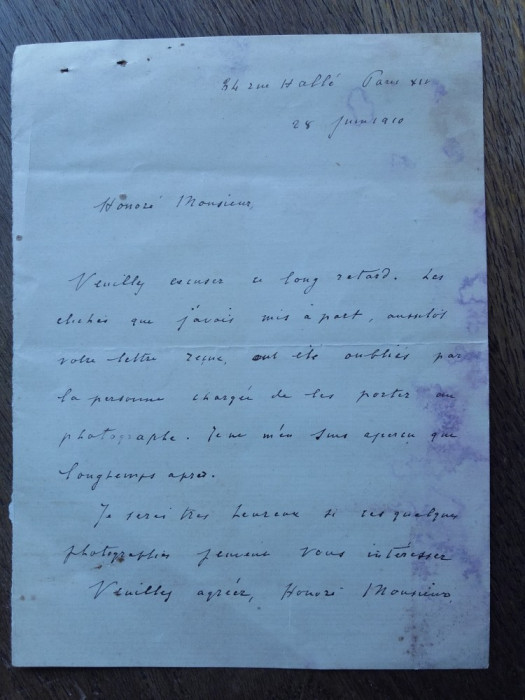Byzantinist archaeologist and art
historian; Professor at the Collège de France, Sorbonne and École
Pratique des Hautes Études. Millet's father was a colonel stationed
with the Marine division of France in Senegal. Orphaned at eighteen
months, Millet was raised in Nice by his grandmother where he
initially studied. He continued his studies in Paris, attending
lectures by the Greek-language philologist Jean Psichari
(1854-1929) and the linguist Antoine Meillet (1866-1939). Millet
graduated 1891 in history and was named a member of the École
française d'Athènes (French School in Athens). There he became
fascinated with the extant Byzantine monuments, initially studying
the 11th-century Byzantine monastery of Daphni outside the city. In
1894 Millet made his first visit to Mount Athos, the collection of
monasteries which hold rich Byzantine manuscripts and painting.
Many of these manuscripts and objects were undocumented and
unresearched. This work was the beginning of what would become a
series of important publications for Millet and establish his
reputation. His later travels included Attica, Epirus (Arta), in
Macedonia (Thessalonike), in Beotia and in the Peloponnese. He
returned to Athos in 1898, documenting the architectural monuments
and manuscripts through photography. Millet led missions of study
to Dalmatia and Istria (in 1897, and again in 1901), where he
helped excavate the 6th-century Euphrasian Basilica at Poreč
(Parenzo). During many of his travels, his wife, Sophie Millet (d.
1953), produced on-the-spot watercolors. His monograph on
Daphni,
Le Monastère de Daphni: histoire,
architecture, mosaïques appeared in 1899,
still the only scholarly work on that monastery. The same year
Millet received a teaching appointment in the religious sciences
section of the École Pratique des Hautes Études. Millet created a
center at the École in 1903 to house his notes and other material,
which he called The Christian and Byzantine Collection. His study
on the Mount Athos inscriptions,
Recueil des
inscriptions chrétiennes de l'Athos was
issued in 1904. He researched in Serbia, Macedonia and Montenegro
between 1905 and 1906, travels which would become the foundation
for his later work on Slavic and Balkin art. Millet was appointed
head of the École in 1906. He continued to publish his findings
with his book on the monuments of
Mistra,
Monuments byzantins de Mistra:
Matériaux pour l'étude de l'architecture et de la peinture en Grèce
aux XIVème et XVème siècles in 1910. A book
on church architecture in Greece,
L'École grecque dans
l'architecture byzantine appeared in 1916.
That year, too, he published an innovative book on the iconography
of the Gospel in the fourteenth, fifteenth and sixteenth centuries
based on his findings of Mistra, Macedonia and Mount
Athos,
Recherches sur l'iconographie de
l'évangile aux XIVe, XVe et XVIe siècles, d'après les monuments de
Mistra, de la Macédoine et du Mont-Athos. The book established
the importance of the last centuries of the Byzantine Empire for
art. Millet continued to visit Mount Athos in 1918, 1919 and
1920.
Lancien art serbe, the first of a
series on Slavic art, appeared in 1919.
His
Monuments de l'Athos relevés avec le
concours de l'armée française d'Orient et de l'École françise
d'Athènes appeared in 1927, the same year he
was appointed chair of aesthetics and history of art at the College
de France. Millet was elected to the Académie des Inscriptions et
Belles-Lettres in 1929. He maintained his position at the École at
the same time. His final research and photographic campaigns, from
the mid-1920s until 1935 concentrated on Balkan monuments of the
Palaeologan period, monuments considered a decline of style. He
established the Archives of Athos. He collaborated
with
David
Talbot Rice, who had studied with him at the Collège de France,
on the book
Byzantine Painting at
Trebizond in 1936, retiring the same year to
be succeeded at the école by
André Grabar. Among his final publication,
Millet opened the study of religious
embroidery,
Broderies religieuses de style
byzantin (with Helene des Ylouses) in 1939,
and
La dalmatique du Vatican; les élus, images
et croyances, in 1947. His work on Balkan art appeared
posthumously, published in 1954 through 1969 by A. Frolow and T.
Velmans. His most distinguished student, at the École Pratique des
Hautes Études, was
Sirarpie Der
Nersessian.
Andreas Xyngopoulos and Frolow
were also students. Millet's reputation as an historian came on the
resurgence of Byzantine studies at the end of the nineteenth and
start of the twentieth centuries (Jolivet-Lévy).
His
Recherches sur
l''iconographie revealed the importance of
the last centuries of Byzantium, and though some findings are today
discounted, it is still a rich source of iconography. He was the
first to scholar to systematically examine of the art of Armenia
(Frolow). His fairness as a scholar extended to those outside his
theoretical mindset, including
Josef Strzygowski. Millet's most important
accomplishments is arguably the creation of a great corpus of
documentation on Byzantine art. His notes, plans, architectural
drawings, copies of inscriptions and manuscripts, sketches and
watercolors and an impressive quantity of photographs on glass
plates are a trove of material, some of works no longer extant.
Millet further built this collection with donations from other
Byzantinists researchers to a collection central for Byzantine
research.








